Subtracting Polynomials
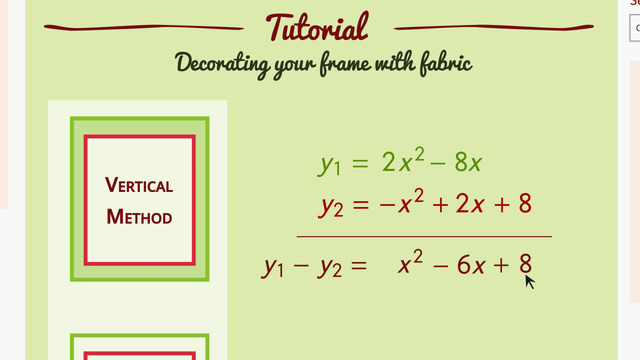

Basics on the topic Subtracting Polynomials
To add and subtract polynomials, first write each polynomial in the standard form. To write in the standard form, order the terms of a polynomial by descending degree.
The degree of a term is determined by the power of each term. If there is more than one variable in a term, add the powers to determine the degree. For example, the term x³y² is a 5th degree. Also, remember the power of a constant has a hidden exponent of 1. For example, 7 is equal to 7 raised to the forst power and is a first degree term.
Once you have ordered the polynomials in standard form, set up the equation vertically or horizontally – whichever is easiest for you to solve. Make sure to distribute the minus sign to all the terms in the polynomial you are subtracting. This is the same as multiplying the entire polynomial by negative 1.
Next, simplify the like terms. Be careful, sometimes unlike terms can fool you. Like terms must have the same combination of variables and powers. Remember you can check your solution by using the inverse operation of addition.
To review how to set up polynomial subtraction problems vertically and horizontally, watch this video and have fun while you learn some tips and tricks to make problem solving faster and more accurate.
Perform arithmetic operations on polynomials.
CCSS.MATH.CONTENT.HSA.APR.A.1
Transcript Subtracting Polynomials
Ross is very much in love with his girlfriend, Raquel. For her birthday, he wants to give her something made with love. He found an old frame in his garage that he wants to fix up so he can frame a picture of himself to give to Raquel. In order to revamp the frame, he decides to order some scraps of fabric online.
The website offers various sizes of fabric. Ross needs to measure the frame before he decides how much fabric to buy. He needs to be careful because he doesn't want to include the space the picture will occupy in his measurements.
Polynomial Subtraction
To find the size of the frame, Ross can use polynomial subtraction. While browsing a do-it-yourself blog, Ross finds two formulas to use. y₁ = 2x² - 8x represents the area of the frame, including the picture. And y₂ = x² - 2x - 8 represents only the inner area of the frame. In order to find the area of the frame without the picture, Ross needs to subtract the area of the picture (y₂) from the area of the whole frame (y₁).
Vertical Method
There are two methods for doing this. First, let's do the vertical method. Make sure the polynomial expressions are in standard form. This means that the terms are in descending order according to their degree. Here they are.
When we subtract a polynomial, we need to make sure we subtract all of the terms. To do this, we need to distribute the minus, which is the same as multiplying by -1, to each term. Now we can add or subtract term by term according to the signs.
2x² - x² equals x². -8x +2x equals -6x, and because we don't have a constant in our first equation, we can add 0 plus 8, which equals 8. Ross just has to plug in the width of his frame for 'x' to find out how much fabric he needs.
Horizontal Method
Another way to subtract polynomials is by using the horizontal method. Again, first make sure that they are in standard form. We can distribute the subtraction sign to all terms inside the parentheses, just like we did before. So that gives us 2x² - 8x - x² + 2x + 8. Now we can rearrange the order so that all of the like terms are next to each other, horizontally. 2x² - x² simplifies to x² then -8x + 2x combine to make -6x. 8 does not have any like terms to combine with, so we will just bring plus 8 down. The resulting answer is x² -6x +8.
Adding Vertically
Let's look at one more example. When adding vertically, put the expression in standard form, then make sure that all of the like terms are lined up together. Here we'll need to move the +2 so that it's above -4 because they're both constants. After combining like terms, you end up with 2x² +2x-2.
But be careful! Sometimes you have polynomials that look like this. The first term has a combination of variables. It may seem like you can combine it with the other two terms but you canNOT. When combining terms, the variables need to look alike. They must have the same combination of variables and each variable must be raised to the same degree.
Alright, now that Ross has finished the frame he gets to give it to his girlfriend Raquel. But she isn't as excited as he thought she would be...because now she has 121 framed pictures of Ross...
Subtracting Polynomials exercise
-
Explain how to calculate the amount of material needed for the frame.
HintsInstead of subtracting a term, you can also add the negative of a term.
If you have a parentheses with a minus in front, you should multiply each term inside the parentheses by $-1$.
Remember, you can only combine like terms.
SolutionTo find out how much material Ross needs for the frame, he has to subtract $x^2-2x-8$ from $2x^2-8x$.
To do this, we can use the vertical function addition method:
First, we write both equations, one below the other:
$\begin{array}{rr} y_1=&2x^2-8x~~~~~\,~~~\\ -y_2=&-(~~x^2-2x-8) \end{array}$
Instead of subtracting the term inside the parentheses, we can also add the negative of this term:
$\begin{array}{rr} y_1=&2x^2-8x~~~~~~~\\ -y_2=&-x^2+2x+8 \end{array}$
Now, we combine the like terms to get $y_1-y_2=x^2-6x+8$.
-
Calculate the difference with the vertical function addition method.
HintsKeep the distributive property in mind:
$-(a+b-c)=-a-b+c$
Multiplying an entire expression by $-1$ is the same as changing the sign of each term inside the parentheses.
Here are some examples for combining like terms:
- $2x+4x=6x$
- $3-x^2+x^2=3$
- $2x-4+4x+3=6x-1$
You can add or subtract like terms by adding or subtracting the coefficients of those terms.
SolutionTo subtract polynomials we can use the vertical function addition method. This means that we write the polynomial one below the other.
$\begin{array}{l} ~~~~\,3x^2+2\\ -(~~x^2-2x+4) \end{array}$
Next, we change the sign of the polynomial we want to subtract.
$\begin{array}{l} ~3x^2+2\\ -x^2+2x-4 \end{array}$
Now, we rearrange the terms in such a way that the like terms are lined up vertically.
$\begin{array}{r} 3x^2~~~~~~~~~+2\\ -x^2+2x-4 \end{array}$
Finally, we can combine the like terms and get the result $2x^2+2x-2$.
-
Examine the variables in the expressions and determine whether or not you can subtract them from the given expressions.
HintsYou can only combine like-terms. These are terms for which the variable combination, as well as the degree of each variable are identical.
Keep the following in mind:
When subtracting composed terms such as $2x^3y^3$, the variables should be identical.
For example, the variable pair for $2x^3y^3$ is $x^3y^3$.
We cannot subtract a portion of the variable pair.
So $x^3y^3 - x \ne x^2y^3$.
SolutionIt's very important to keep in mind that you can only combine like-terms.
As a special example, we have the combination of variables $y^2x$. It's absolutely impossible to add or subtract a portion of the variables, such as $y^2$, $y$ or $x$.
$\mathbf{y^2x+3x}$
- $5x$
- $x-2y^2x$
- $4y^2x$
- $7y^2$
- $y-xy$
- $-y^2+2y$
-
Determine the equation for the border of the flower patch.
HintsTo write an expression in standard form, arrange the terms according to degree, decreasing from left to right.
You can add or subtract like-terms by adding or subtracting their coefficients.
You can use the horizontal or the vertical method of combining polynomials. It doesn't matter which method you use, the result is always the same.
SolutionHere you can see how to subtract polynomials using the horizontal method. You can use the vertical method as well.
First, we write each equation in standard form.
$5x+3x^2=3x^2+5x$
$2x^2-3+2x=2x^2+2x-3$
Now we have
$(3x^2+5x)-(2x^2+2x-3) = 3x^2+5x-2x^2-2x+3$
Next we combine the like-terms.
$3x^2+5x-2x^2-2x+3 = (3x^2-2x^2)+(5x-2x)+3$
Finish it off with PEMDAS.
$(3x^2-2x^2)+(5x-2x)+3 = x^2+3x+3$
-
Analyze each statement about subtracting polynomials.
HintsHere, you can see an example of how to write a polynomial in standard form.
The different terms are arranged in decreasing degree, from left to right.
You can imagine the combination of terms as the following:
- Two apples plus three apples are $2+3=5$ apples.
- You can't add two apples to three pears.
Above is an example of the horizontal method for subtracting two polynomials.
SolutionWhat do you have to keep in mind when subtracting polynomials?
- Write each polynomial in standard form: Arrange the terms according to degree, decreasing from left to right.
- You can only combine like-terms.: There is no way to combine the terms $2x$ and $-5y^2$, for instance.
- Composed terms: When subtracting composed terms, such as $3xy^2$, the variables should be identical. For example, the variable pair for $3xy^2$ is $xy^2$. We cannot subtract a portion of the variable pair. So $xy^2 - x \ne y^2$.
-
Solve the following subtraction problems.
HintsYou can use the vertical or horizontal method for combining polynomial expressions.
Remember to only combine like terms.
Like terms are terms in which the variable combination as well as the degree of the exponents are identical.
Here you can see an example of how to combine like terms.
$\begin{array}{rcl} 7xy-3x+5x-2xy&=&(7xy-2xy)+(-3x+5x)\\ &=&5xy+2x \end{array}$
SolutionThe vertical method of combining polynomials will be used for the first two examples and the horizontal method will be used for the remaining two.
${(2xy+3x-4)-(3x^2+2xy-6)}$
$\begin{array}{rcccccccc} &&&2xy&+&3x&-&4\\ &-&(&3x^2&+&2xy&-&6&) \end{array}$
First, we change the sign of the inferior polynomial and rearrange the monomials.
$\begin{array}{rcccccccc} &&&2xy&&+&3x&-&4\\ -&3x^2&-&2xy&&&&-&6& \end{array}$
Finally, we combine the like terms to $-3x^2+3x-10$.
$~$
${(2x^2+3xy^2-4x)-(3x^2y+4x^2-6x)}$
$\begin{array}{rccccccccccc} &&2x^2&+&3xy^2&-&4x&\\ &-&3x^2y&-&4x^2&+&6x& \end{array}$
Again, we change the sign of the inferior polynomial and rearrange the monomials.
$\begin{array}{rccccccccccc} &&&&3xy^2&+&2x^2&-&4x&\\ &-&3x^2y&&&-&4x^2&+&6x& \end{array}$
Combining like terms, we get $-3x^2y+3xy^2-2x^2+2x$.
$~$
${(3x^2y^2+3x^2y-4xy^2+4x)-(6xy^2-4x^2y+2x^2)}$
First, we arrange the second term in standard form.
$6xy^2-4x^2y+2x^2=-4x^2y+6xy^2+2x^2$
$(3x^2y^2+3x^2y-4xy^2+4x)-(6xy^2-4x^2y+2x^2)$ $=3x^2y^2+3x^2-4y^2+4x+4x^2y-6xy^2-2x^2$
Now we combine the like terms.
$3x^2y^2+3x^2y-4xy^2+4x+4x^2y-6xy^2-2x^2$ $=3x^2y^2+(3x^2y+4x^2y)+(-4xy^2-6xy^2)-2x^2+4x$.
Almost done, just one more step.
$3x^2y^2+(3x^2y+4x^2y)+(-4xy^2-6xy^2)-2x^2+4x$ $=3x^2y^2+7x^2y-10xy^2-2x^2+4x$
$~$
${(12x+4xy^2+3x^2+7)-(3x^2+7xy-5x+6)}$
First, arrange the first expression in standard form.
$12x+4xy^2+3x^2+7=4xy^2+3x^2+12x+7$
$(4xy^2+3x^2+12x+7)-(3x^2+7xy-5x+6)=$
Now, combine the like terms.
$(4xy^2+3x^2+12x+7)-(3x^2+7xy-5x+6)$ $=4xy^2+(3x^2-3x^2)-7xy+(12x+5x)+(7-6)$.
The last step!
$4xy^2+(3x^2-3x^2)-7xy+(12x+5x)+(7-6)=4xy^2-7xy+17x+1$
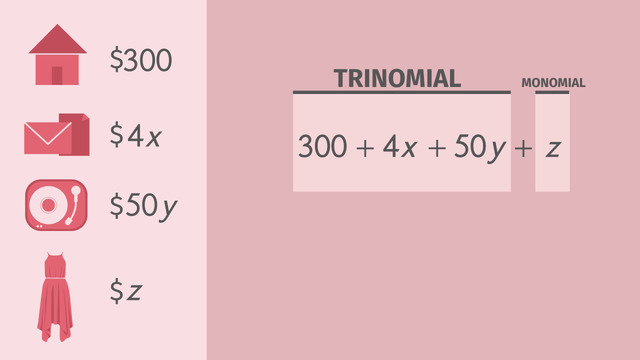
Introduction to Polynomials – Naming Polynomials by Number of Terms
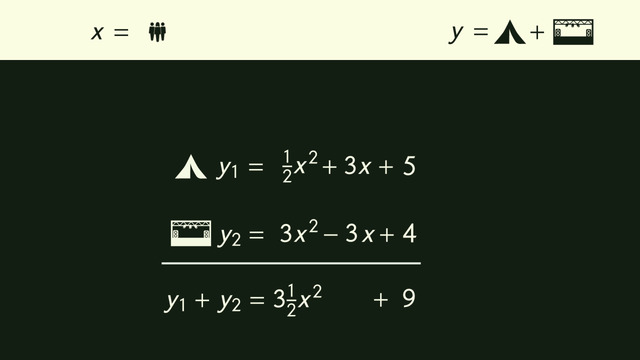
Adding Polynomials

Multiplying Polynomials
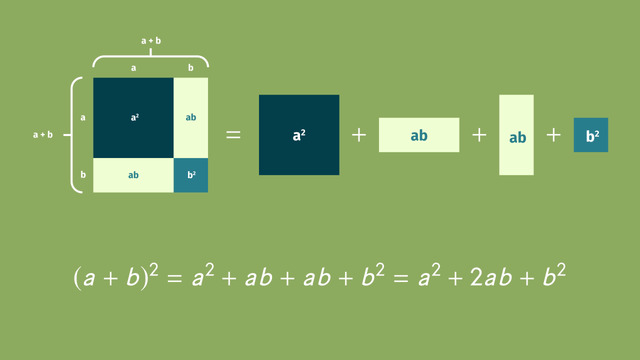
Multiplying Special Case Polynomials
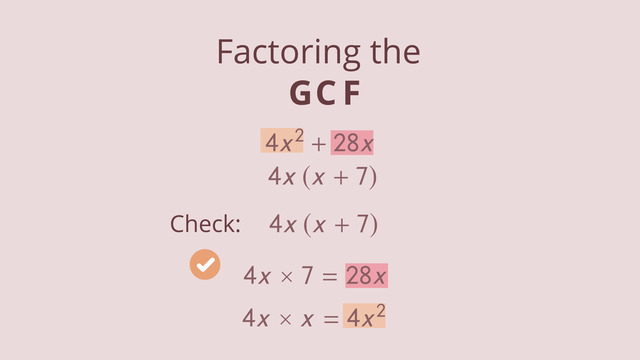
Factoring out the GCF
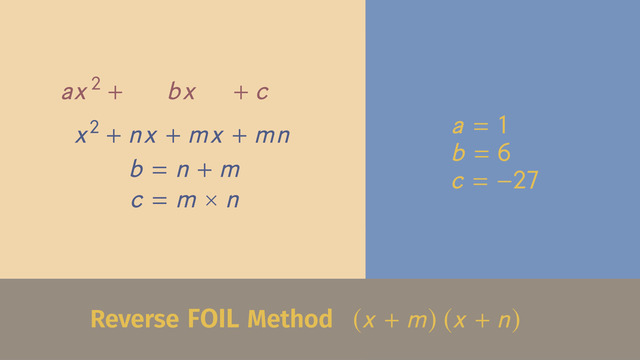
Factoring Trinomials with a = 1

Factoring Trinomials with a ≠ 1
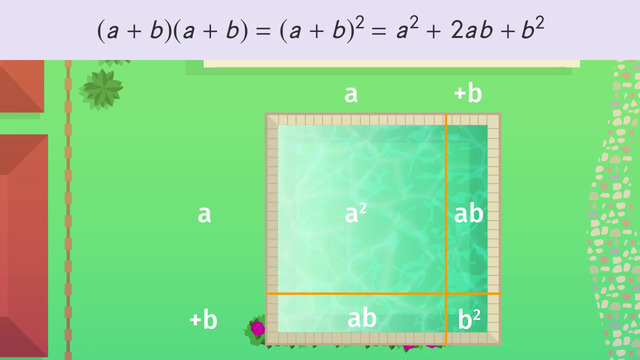
Factoring Special Case Polynomials
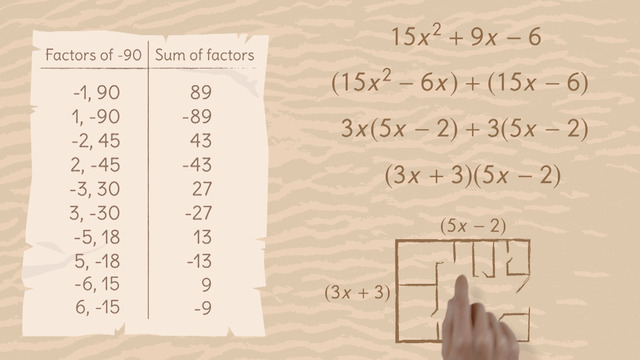
Factoring by Grouping

Subtracting Polynomials











